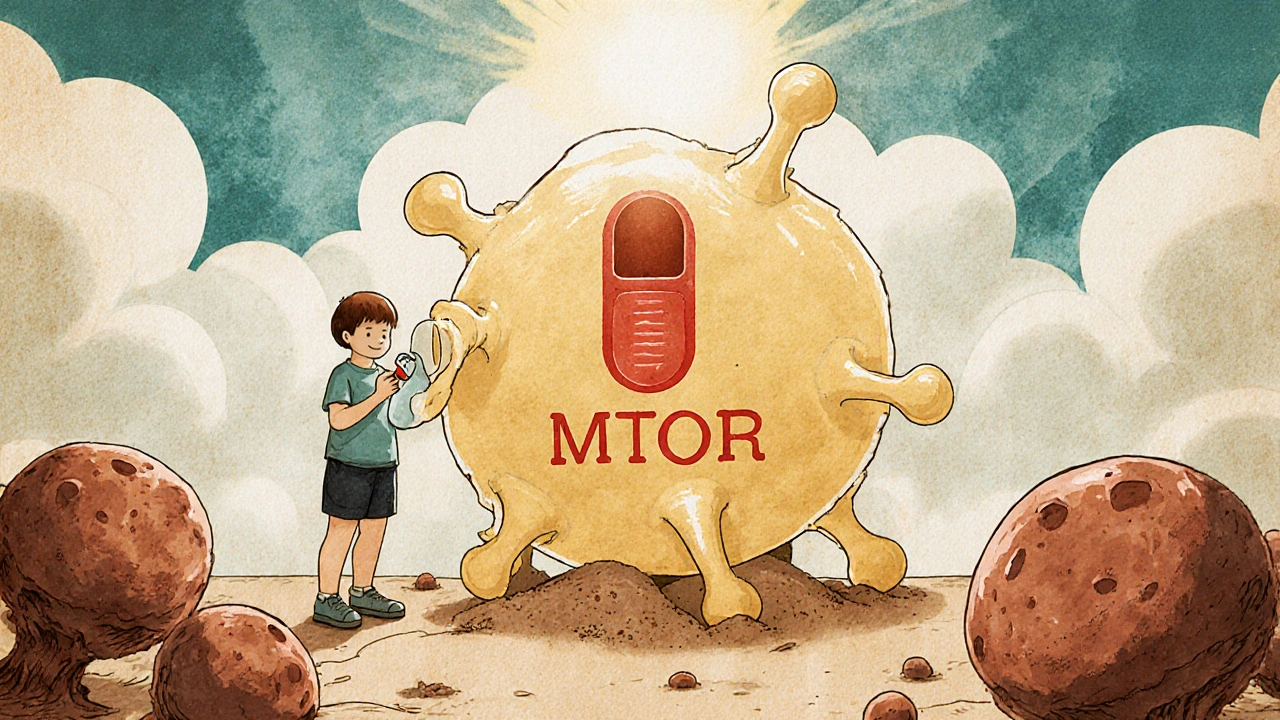Everolimus: How This Drug Is Changing Outcomes for Rare Disease Patients
For patients with rare diseases, hope often comes in small doses. One of those doses is everolimus - a drug once used only in transplant patients, now turning the tide for people with conditions that once had no real treatment options. It doesn’t cure these diseases, but it slows them down. It buys time. It lets people live longer, healthier lives. And for many, that’s everything.
What Everolimus Actually Does
Everolimus is an mTOR inhibitor. That means it blocks a protein called mTOR - short for mammalian target of rapamycin - which acts like a gas pedal for cell growth. In healthy people, mTOR helps cells grow and divide when needed. But in rare diseases like tuberous sclerosis complex (TSC) and lymphangioleiomyomatosis (LAM), this pedal gets stuck. Cells multiply out of control, forming tumors in the brain, kidneys, lungs, and skin.
Everolimus steps in and hits the brakes. In clinical trials, it shrank kidney tumors in up to 42% of TSC patients. In LAM, it improved lung function by an average of 12% over two years. These aren’t minor gains. For someone with LAM, breathing better means walking across the room without stopping. For a child with TSC, fewer seizures mean going to school instead of staying home.
Conditions Treated by Everolimus Today
Everolimus isn’t a magic bullet for every rare disease. But it’s approved for several that were once considered untreatable:
- Tuberous Sclerosis Complex (TSC): A genetic disorder causing benign tumors in multiple organs. Everolimus reduces the size of subependymal giant cell astrocytomas (SEGAs) in the brain and renal angiomyolipomas in the kidneys.
- Lymphangioleiomyomatosis (LAM): A lung disease mostly affecting women of childbearing age. Everolimus slows the destruction of lung tissue and reduces the need for oxygen therapy or transplants.
- Subependymal Giant Cell Astrocytoma (SEGA): A type of brain tumor linked to TSC. Everolimus is the first non-surgical option to shrink these tumors.
- Advanced Neuroendocrine Tumors (NETs): Though not always classified as rare, NETs affect fewer than 10 people per 100,000. Everolimus extends progression-free survival by nearly 11 months compared to placebo.
Each of these conditions has one thing in common: they’re driven by mutations in the TSC1 or TSC2 genes. These mutations hyperactivate mTOR. Everolimus targets that exact flaw. That’s why it works so well - it’s precision medicine in action.
How Patients Experience Everolimus Day to Day
Patients don’t take everolimus like a vitamin. It’s a daily pill, taken with water, on an empty stomach. No grapefruit. No St. John’s wort. No sudden changes in diet or supplements. One mistake can throw off blood levels and reduce effectiveness - or cause side effects.
Common side effects include mouth sores (stomatitis), fatigue, rash, and increased risk of infection. About 1 in 5 patients develop pneumonia. But these are manageable. Doctors start low - 5 mg or 7.5 mg daily - and adjust based on blood tests. Mouth sores can be treated with saltwater rinses. Fatigue is eased with rest and light exercise. Most patients adapt within 3 to 6 months.
One mother from Ohio told her doctor: “Before everolimus, my daughter had 15 seizures a week. Now she has one every three weeks. She’s in second grade. She remembers her multiplication tables. That’s a win.”

How Everolimus Compares to Other Treatments
| Condition | Everolimus | Traditional Treatment | Effectiveness |
|---|---|---|---|
| Tuberous Sclerosis (kidney tumors) | Reduces tumor size by 30-50% | Surgery, embolization | Higher long-term control, fewer repeat procedures |
| Lymphangioleiomyomatosis (LAM) | Improves lung function by 10-15% | Oxygen therapy, lung transplant | Delays transplant need by 3-5 years |
| SEGA brain tumors | Shrinks tumors in 40-60% of patients | Neurosurgery | Non-invasive, avoids brain damage risk |
| Neuroendocrine Tumors | Extends progression-free survival by 11 months | Chemotherapy, somatostatin analogs | Better tolerability, oral dosing |
Unlike chemotherapy, everolimus doesn’t wipe out healthy cells. It’s targeted. That means fewer nausea episodes, less hair loss, and no hospital stays for infusions. For families juggling school, work, and care, that’s a game-changer.
Who Shouldn’t Take Everolimus
Not everyone can take it. Everolimus isn’t safe for:
- People with severe liver problems - the drug is processed by the liver, and buildup can be toxic
- Pregnant women - it can cause birth defects
- Those with active infections - it weakens the immune system
- Patients on strong CYP3A4 inhibitors like ketoconazole or clarithromycin - these raise everolimus levels dangerously
Doctors always check liver enzymes, blood counts, and cholesterol before starting. Blood levels are monitored monthly for the first three months, then every 3 to 6 months. It’s not a drug you start and forget. It’s a long-term partnership with your care team.

The Future of Everolimus in Rare Diseases
Research is expanding. Trials are underway for other conditions where mTOR is overactive: Peutz-Jeghers syndrome, Cowden syndrome, and even some forms of autism linked to TSC mutations. Early results show promise in reducing behavioral symptoms in children with TSC-related autism.
Scientists are also testing everolimus in combination with other drugs - like VEGF inhibitors - to boost its effect. One 2024 phase 2 trial combining everolimus with bevacizumab in LAM patients showed a 25% greater improvement in lung function than everolimus alone.
And cost? It’s expensive - about $12,000 a month in the U.S. But most insurance covers it for approved uses. Patient assistance programs from Novartis (the maker) can reduce out-of-pocket costs to under $10 a month for qualifying families.
What Patients and Families Need to Know
If you or someone you love has been prescribed everolimus:
- Take it exactly as directed - even if you feel fine.
- Keep all lab appointments. Blood tests aren’t optional.
- Report mouth sores, fever, or breathing changes right away.
- Use a pill organizer. Missing doses reduces effectiveness.
- Connect with patient groups - like the Tuberous Sclerosis Alliance or LAM Foundation. You’re not alone.
This drug doesn’t erase the disease. But it changes the story. It turns a diagnosis from a death sentence into a chronic condition - one you can manage, live with, and even thrive beyond.
Is everolimus a chemotherapy drug?
No, everolimus is not chemotherapy. It’s a targeted therapy that blocks a specific protein (mTOR) involved in abnormal cell growth. Chemotherapy attacks all rapidly dividing cells, including healthy ones, which causes side effects like hair loss and nausea. Everolimus is more precise, which usually means fewer severe side effects.
How long do patients stay on everolimus?
Most patients stay on everolimus long-term - often for years or even life. Stopping the drug can cause tumors to regrow quickly. For conditions like LAM and TSC, it’s a maintenance therapy, not a short-term fix. Doctors monitor for side effects and adjust the dose, but the goal is continuous use.
Can children take everolimus?
Yes, everolimus is approved for children as young as 1 year old with tuberous sclerosis complex. Dosing is based on body surface area, not weight. Studies show it’s effective and generally well-tolerated in kids, with side effects like mouth sores and infections being the most common. Regular monitoring is essential.
Does everolimus cure rare diseases?
No, everolimus does not cure these diseases. It controls them. It slows tumor growth, improves lung function, and reduces seizures - but it doesn’t fix the underlying genetic mutation. Patients need to keep taking it to maintain benefits. Research into gene therapies is ongoing, but everolimus remains the most effective treatment available today.
What happens if I miss a dose?
If you miss a dose, take it as soon as you remember - but only if it’s within 6 hours of the usual time. If it’s been longer, skip the missed dose and go back to your regular schedule. Never double up. Missing doses can lower the drug’s effectiveness and increase the risk of tumor regrowth.
Everolimus didn’t come from a lab overnight. It took decades of research, failed trials, and patient stories that pushed science forward. Today, it’s one of the few drugs that turns the phrase “rare disease” from a label of despair into a challenge we’re learning to manage - one pill at a time.







10 Comments
shivam mishra
October 31, 2025 at 16:09
Just saw this and had to chime in - I work with TSC families in Bangalore, and everolimus has been a game-changer. One kid I know went from 20 seizures a week to maybe one every two weeks. His mom cried when he recited his ABCs again. It’s not a cure, but it gives you back pieces of life you thought were gone forever.
Scott Dill
November 2, 2025 at 05:23
Bro this is wild. I had no idea this drug was doing this much for LAM. My cousin’s on it and she went from needing oxygen 24/7 to hiking half a mile without stopping. I thought it was just another expensive pill. Turns out it’s like giving someone their lungs back.
Arrieta Larsen
November 2, 2025 at 18:57
My daughter started everolimus at age 4. The mouth sores were brutal at first. But after three months? She started laughing again. Really laughing. Not just smiling. The kind that makes you forget she has a brain tumor. Worth every side effect.
Mike Gordon
November 4, 2025 at 04:37
Everolimus isn't magic but it's the closest thing we've got. I've seen patients who were on death's door, now coaching little league. The science is solid. The cost? Yeah it's insane. But Novartis has programs. Call them. Don't give up before you even try.
Kathy Pilkinton
November 5, 2025 at 15:52
Let’s be real - this drug is basically a Band-Aid on a bullet wound. They call it ‘precision medicine’ but it’s just another way to milk families for $12k a month while pretending they care. And don’t get me started on how they market this as ‘hope’ - it’s just prolonging suffering with a pill.
Holly Dorger
November 6, 2025 at 11:50
I’m a nurse in Philly and I’ve watched so many kids on everolimus. Some get the side effects bad - infections, rashes, fatigue. But the ones who stick with it? They go to prom. They graduate. They text their moms ‘I love you’ before bed. That’s not nothing. Don’t let the cost scare you off - there’s help out there.
MOLLY SURNO
November 6, 2025 at 22:47
The data is compelling. The long-term outcomes for TSC and LAM patients on everolimus show measurable improvement in quality of life metrics. While not curative, the pharmacological targeting of mTOR represents a paradigm shift in rare disease management. Continued monitoring remains essential.
Alex Hundert
November 8, 2025 at 18:02
Kathy above is being dramatic. Yes, it’s expensive. But if your kid stops seizing and goes to school? That’s worth it. I’ve seen parents sell cars, take second jobs, sleep in hospital chairs - just to keep their child on this drug. It’s not perfect. But it’s the best shot they’ve got. Stop complaining and start helping.
Emily Kidd
November 9, 2025 at 16:29
My sister’s on it for LAM and honestly? The hardest part isn’t the pill - it’s remembering not to eat grapefruit. I kept forgetting and she’d get all dizzy. Now we have a sticky note on the fridge. Also, her doc says to use a pill box - life saver. Don’t skip doses. Even one missed can make a difference.
Justin Cheah
November 10, 2025 at 14:49
Everolimus is just the tip of the iceberg. The real story? Big Pharma bought the mTOR patent in 2003 and buried gene therapy research because cures don’t make money. They want you dependent on pills forever. The FDA approved it fast because Novartis paid off the regulators. Look up the 2017 whistleblower report. They knew about the liver toxicity risks. They just didn’t care. Your ‘hope’ is a corporate profit model. Wake up.